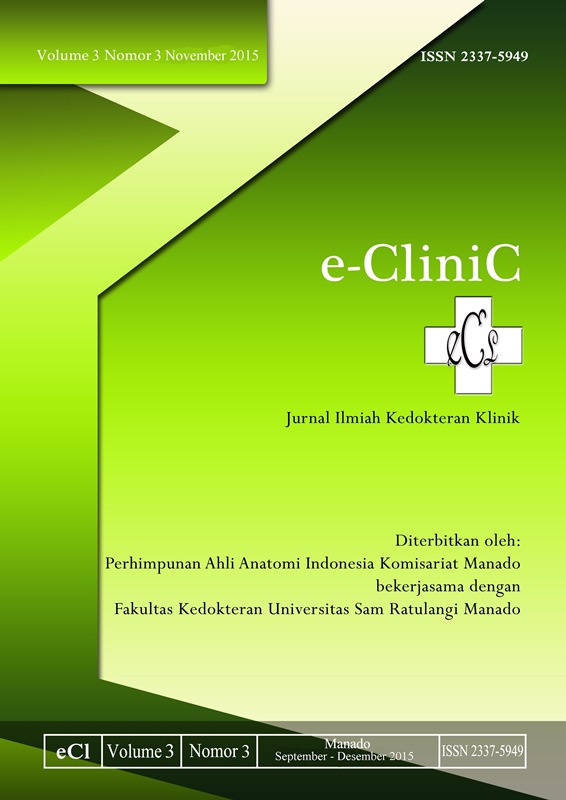PERBANDINGAN NYERI PASCA SEKSIO SESAREA PADA PENDERITA YANG DIBERIKAN KETOROLAK DAN TRAMADOL DENGAN PETIDIN
DOI:
https://doi.org/10.35790/ecl.v3i3.10593Abstract
Abstract: Anesthesia can not be separated from surgery and other medical procedures that cause pain. General anesthesia is associated with loss of consciousness (sedation), loss of perception of pain (analgesia), and suppression of motor reflexes of the body that allows the immobilization of the patient (areflexia). Pain is an unpleasant sensory and emotional experience that is associated with tissue damage that has or potentially occur, or can be explained by the damage. Postoperative pain should be adequately controlled because if the pain is not adequately relieved it can lead to discomfort and affect the pulmonary, cardiovascular, gastrointestinal, endocrine, and immunological systems. This study aimed to determine the value of post-operative pain in patients with caesarean section and to compare the value of pain after administration of ketorolac and tramadol with pethidine on 0, 2, 4, 6 hours. This was a prospective analytical study. There were 16 cases of cesarean section selected according to the inclusion and exclusion criteria. Patients were divided into 2 groups: the first group for the combination of ketorolac and tramadol and the second group for pethidine. The data were measured by using VAS pain scale, and were statistically analyzed by using independent t test and Man Whitney U test. The ketorolac and tramadol group showed an increase of VAS score averages: 0 in hour-0; 1 in hour-2; 4.5 in hour-4; and 6.5 in hour-6. The pethidine group showed the VAS score averages: 0 in hour-0 until hour-2; 7 in hour-4; and 9.6 in hour-6. Conclusion: There were differences in the post-caesarean section pain which were significant in the hour-4 and hour-6 between tramadol and ketorolac group and the pethidine group. Moreover, the average value of VAS scale was lower in the ketorolac and tramadol group than of the pethidine group.
Keywords: caesarean section, VAS scale pain, ketorolac, tramadol, pethidine
Abstrak: Anestesia tidak dapat dipisahkan dari pembedahan dan berbagai prosedur medis lain yang menimbulkan rasa sakit. Anestesi umum dihubungkan dengan hilangnya kesadaran (sedasi), hilangnya persepsi nyeri (analgesia) dan tersupresinya refleks–refleks motorik tubuh, memungkinkan imobilisasi pasien (arefleksia).Nyeri adalah suatu pengalaman sensorik dan emosional yang tidak menyenangkan yang berkaitan dengan kerusakan jaringan yang sudah atau berpotensi terjadi, atau dijelaskan berdasarkan kerusakan tersebut. Nyeri pasca operasi harus dikontrol secara adekuat sebab nyeri yang tidak diatasi secara adekuat dapat mengakibatkan ketidaknyamanan serta mempengaruhi sistem pulmonary, kardiovaskular, gastrointestinal, endokrin, dan imunologik. Penelitian ini bertujuan untuk mengetahui nilai nyeri pada pasien pasca operasi seksio sesarea dan membandingkan nilai nyeri setelah pemberian ketorolak dan tramadol dengan pemberian petidin pada jam ke 0, 2, 4, dan 6. Penelitian ini merupakan studi analitik prospektif. Terdapat 16 kasus bedah sesar yang memenuhi kriteria inklusi dan eksklusi. Pasien dibagi menjadi 2 kelompok, yakni kelompok I untuk kombinasi ketorolak dan tramadol; dan kelompok II untuk petidin. Data yang dikumpulkan diukur dengan skala nyeri VAS, kemudian data dianalisis dengan menggunakan uji t independent dan uji Man Whitney U. Pada skor VAS kelompok ketorolak tramadol terjadi peningkatan nilai rerata dari jam ke-0 sebesar 0; pada jam ke-2 menjadi 1; pada jam ke-4 menjadi 4,5; dan pada jam ke-6 meningkat menjadi 6,5. Pada skor VAS kelompok petidin nilai rerata dari jam ke-0 sebesar 0; tetap stabil pada angka 0 pada jam ke-2; pada jam ke-4 menjadi 7; dan pada jam ke-6 menjadi 9,6. Simpulan: Terdapat perbedaan rasa nyeri yang sangat bermakna pada jam ke-4 dan jam ke-6 antara kelompok ketorolak + tramadol dan kelompok petidin. Nilai rerata VAS pada kelompok ketorolak + tramadol lebih rendah dibandingkan nilai rerata VAS pada kelompok petidin.
Kata kunci: seksio sesarea, skala nyeri, ketorolak, tramadol, petidin
Downloads
How to Cite
Issue
Section
License
COPYRIGHT
Authors who publish with this journal agree to the following terms:
Authors hold their copyright and grant this journal the privilege of first publication, with the work simultaneously licensed under a Creative Commons Attribution License that permits others to impart the work with an acknowledgment of the work's origin and initial publication by this journal.
Authors can enter into separate or additional contractual arrangements for the non-exclusive distribution of the journal's published version of the work (for example, post it to an institutional repository or publish it in a book), with an acknowledgment of its underlying publication in this journal.
Authors are permitted and encouraged to post their work online (for example, in institutional repositories or on their website) as it can lead to productive exchanges, as well as earlier and greater citation of the published work (See The Effect of Open Access).







